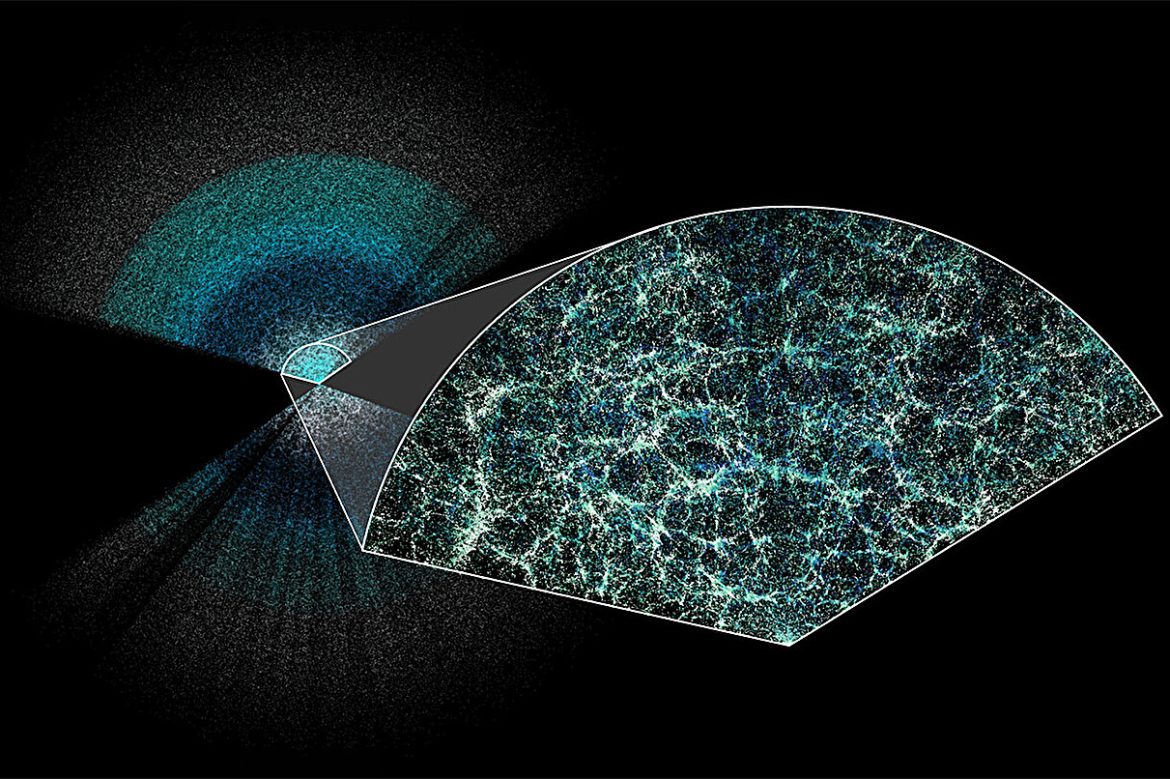
Dark Energy Traces on the 3D Universe Map
To unravel the mystery of dark energy and gain a deeper understanding of the universe’s expansion, scientists have harnessed remarkable technology. The imposing Dark Energy Spectroscopic Instrument (DESI), stationed atop the 4-meter Nicholas U. Mayall Telescope at the Kitt Peak National Observatory in Arizona, boasts 5,000 automated robotic eyes. Through these robotic marvels, scientists have harvested data from the universe’s state 11 billion years ago, illuminating its early history.
The origins and evolution of the universe stand as some of humanity’s most profound inquiries. DESI provides a means to explore the effects of the enigmatic force known as dark energy by voyaging back through time. Dark energy, an elusive force, propels the universe to expand at an ever-increasing pace.
DESI’s monumental achievement lies in crafting a vast three-dimensional map of the universe, yielding the most intricate and precise measurements to date. This map has enabled scientists to chart the expansion history of the nascent universe with unprecedented accuracy, boasting an error margin of less than 1 percent. This constitutes the clearest depiction yet of the universe’s evolution, marking a pivotal stride towards unravelling its future.
Michael Levi, the project’s leader, underscores that while DESI’s data broadly aligns with the prevailing model of the universe, it also unveils subtle inconsistencies hinting that dark energy may evolve over time. He anticipates that these divergences will crystallise with additional data, expressing keen anticipation for the forthcoming analysis of the trove of data to be amassed over the next five years.
The prevailing model of our universe, Lambda CDM, encompasses a form of weakly interacting matter (cold dark matter, or CDM) alongside dark energy (Lambda). Both matter and dark energy wield influence over the universe’s expansion, albeit in opposing directions. While matter and dark matter impede expansion, dark energy propels it forward. The quantities of each substance dictate the universe’s evolutionary trajectory, effectively elucidating findings from prior experiments and the universe’s temporal evolution.
Upon amalgamating DESI’s inaugural findings with data from other inquiries, slight disparities emerged compared to what Lambda CDM had forecasted. As DESI amasses further information during its five-year tenure, these preliminary findings will crystallise, shedding light on whether they indicate alternative explanations or necessitate updates to our prevailing model.
Additional data will also refine DESI’s insights into the Hubble constant (a gauge of the universe’s contemporary expansion rate) and the masses of particles known as neutrinos.
In the universe’s infancy, a seething, dense mix of particles hurtled too swiftly to coalesce into stable matter akin to today’s atoms. Amidst these particles lurked baryons, comprising hydrogen and helium nuclei. Minute perturbations within this primordial plasma sculpted the baryons into undulating waves. As the universe expanded and cooled, neutral atoms emerged, quelling pressure waves and fostering the embryonic galaxies’ condensation zones. Billions of years hence, the faint vestiges of this pattern endure in the characteristic forms of galaxies, christened Baryon Acoustic Oscillations (BAO), furnishing pivotal data for cosmic cartography.
Another method employed to gauge galaxies’ expansion history and unravel the mysteries of dark energy hinges upon quasars—distant, luminous cores of galaxies harbouring supermassive black holes. Quasars’ light undergoes absorption as it traverses intergalactic gas clouds, enabling researchers to chart these clouds and exploit galaxies as cosmic beacons in a technique dubbed the “Lyman-alpha forest.” Utilising 450,000 quasars for these Lyman-alpha forest measurements, scientists have extended BAO measurements back 11 billion years. DESI’s mission entails mapping 3 million quasars and 37 million galaxies, marking the first spectroscopic endeavour to undertake a fully “blinded analysis” to circumvent scientists’ subconscious confirmation bias.
DESI will persist in its data collection endeavours for years to come, ushering in a new era of astronomical exploration. Concurrently, DESI’s data will underpin other seminal astronomical endeavours, including the Vera C. Rubin Observatory and the Nancy Grace Roman Space Telescope. In summation, DESI stands as a pivotal milestone in our odyssey to unravel the universe’s enigmas.
REFERENCES
- 1. https://phys.org/news/2024-04-dark-energy-spectroscopic-instrument-largest.html
- 2. https://www.sciencenews.org/article/map-universe-dark-energy-cosmology-desi
